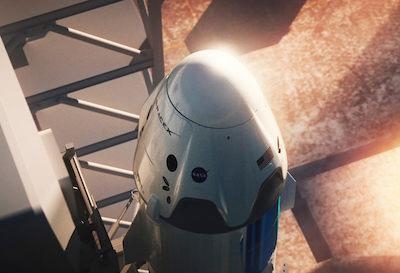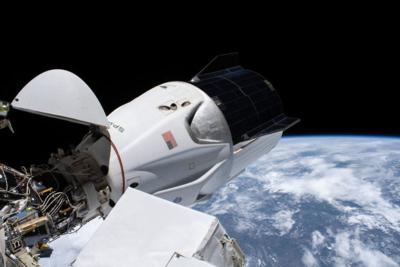Up and Away
A SpaceX Falcon-9 rocket carrying one of the company's Dragon capsules departed the Kennedy Space Center’s Launch Complex 39A at 12:00 EDT on Wednesday, 05 October 2022. The successful launch marked the beginning of NASA’s SpaceX Crew-5 mission to the International Space Station, and the sixth instance of crewed flight aboard SpaceX’s Crew Dragon spacecraft.

The Dragon capsule—dubbed Endurance—will dock autonomously to the space-facing port of the ISS’s Harmony module on Thursday, 6 October at approximately 16:57 EDT. Live coverage of the docking, the hatch opening, and the ceremony welcoming Crew-5’s complement of spacefarers aboard the space station will be provided by NASA Television, the NASA app, and the agency’s website.
Making their way to the International Space Station aboard Endurance are NASA astronaut and mission commander Nicole Mann; NASA astronaut and pilot Josh Cassada; Japan Aerospace Exploration Agency (JAXA) astronaut Koichi Wakata; and Roscosmos cosmonaut Anna Kikina. The Crew-5 mission is the first spaceflight for Mann, Cassada, and Kikina, and the fifth for Wakata.

NASA Administrator Bill Nelson remarked: “Missions like Crew-5 are proof we are living through a golden era of commercial space exploration. It’s a new era powered by the spirit of partnership, fueled by scientific ingenuity, and inspired by the quest for new discoveries. During their stay aboard the International Space Station, Crew-5 will conduct more than two-hundred science experiments and technology demonstrations, including studies on printing human organs in space and better understanding heart disease. While our eyes are focused upward on the heavens, let us never forget these missions will also better life here on Earth.”
During Endurance’s flight, SpaceX will monitor a series of automatic spacecraft maneuvers from its mission control center in Hawthorne, California, and NASA teams will monitor ISS operations throughout the flight from the Mission Control Center at the agency’s Johnson Space Center in Houston.

Mann, Cassada, Wakata, and Kikina will join the space station’s Expedition 68 crew, which comprises NASA astronauts Bob Hines, Kjell Lindgren, Frank Rubio, and Jessica Watkins; ESA (European Space Agency) astronaut Samantha Cristoforetti; and Roscosmos cosmonauts Sergey Prokopyev and Dmitri Petelin.
The combined crews will boost the ISS population to a snug 11 individuals, but only for a short time, as Hines, Lindgren, Watkins, and Cristoforetti—who’ve been living aboard the space station since 27 April 2022—are slated to return to Earth a few days after Endurance docks.
Crew-5 will spend six-months aboard the ISS, during which they’ll conduct scientific experiments germane to cardiovascular health, bioprinting, and fluid behavior in microgravity.
NASA Space Operations Mission Directorate associate administrator Kathryn Lueders stated: “The International Space Station continues to serve a critical role in helping NASA and our partners understand and maximize the unique attributes of the microgravity environment. I am grateful to the many people who worked to ensure a safe Crew-5 launch despite the recent hurricane so the crew can fulfill their mission to the orbiting laboratory.”
The Crew-5 mission instantiates NASA’s desire to keep America at the forefront of human spaceflight. The research and technological innovation and advancement occasioned by regular crewed missions to the ISS lays the groundwork for future human space-exploration such as that not being accomplished by NASA’s Artemis project, which seeks to return mankind to the surface of Earth’s moon, but has thrice failed to venture beyond its launch pad.
 ANN's Daily Aero-Term (04.20.24): Light Gun
ANN's Daily Aero-Term (04.20.24): Light Gun Aero-News: Quote of the Day (04.20.24)
Aero-News: Quote of the Day (04.20.24) ANN's Daily Aero-Linx (04.21.24)
ANN's Daily Aero-Linx (04.21.24) Aero-News: Quote of the Day (04.21.24)
Aero-News: Quote of the Day (04.21.24) ANN's Daily Aero-Term (04.21.24): Aircraft Conflict
ANN's Daily Aero-Term (04.21.24): Aircraft Conflict





